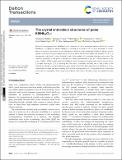The crystal and defect structures of polar KBiNb2O7
Abstract
KBiNb2O7 was prepared from RbBiNb2O7 by a sequence of cation exchange reactions which first convert RbBiNb2O7 to LiBiNb2O7, before KBiNb2O7 is formed by a further K-for-Li cation exchange. A combination of neutron, synchrotron X-ray and electron diffraction data reveal that KBiNb2O7 adopts a polar, layered, perovskite structure (space group A11m) in which the BiNb2O7 layers are stacked in a (0, ½, z) arrangement, with the K+ cations located in half of the available 10-coordinate interlayer cation sites. The inversion symmetry of the phase is broken by a large displacement of the Bi3+ cations parallel to the y-axis. HAADF-STEM images reveal that KBiNb2O7 exhibits frequent stacking faults which convert the (0, ½, z) layer stacking to (½, 0, z) stacking and vice versa, essentially switching the x- and y-axes of the material. By fitting the complex diffraction peak shape of the SXRD data collected from KBiNb2O7 it is estimated that each layer has approximately a 9% chance of being defective-a high level which is attributed to the lack of cooperative NbO6 tilting in the material, which limits the lattice strain associated with each fault.
Citation
Mallick , S , Zhang , W , Batuk , M , Gibbs , A S , Hadermann , J , Halasyamani , P S & Hayward , M A 2022 , ' The crystal and defect structures of polar KBiNb 2 O 7 ' , Dalton Transactions , vol. 51 , no. 5 , pp. 1866-1873 . https://doi.org/10.1039/d1dt04064b
Publication
Dalton Transactions
Status
Peer reviewed
ISSN
1477-9226Type
Journal article
Description
Funding: Experiments at the Diamond Light Source were performed as part of the Block Allocation Group award “Oxford/Warwick Solid State Chemistry BAG to probe composition-structure– property relationships in solids” (CY25166). Experiments at the ISIS pulsed neutron facility were supported by a beam time allocation from the STFC (RB 2000148). SM thanks Somerville College for an Oxford Ryniker Lloyd scholarship. ‘PSH and WZ thank the National Science Foundation (DMR-2002319) and Welch Foundation (Grant E-1457) for support.Collections
Items in the St Andrews Research Repository are protected by copyright, with all rights reserved, unless otherwise indicated.

